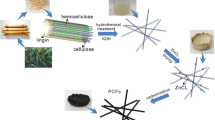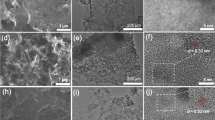Abstract
Agro-waste-derived porous carbon has received more attention as electrode material for high-performance supercapacitor application due to its diversity and reproducibility. Herein, hierarchical porous carbon was successfully synthesized from most abundant biomass onion peel via double crucible method and it was explored as renewable carbon source for low-cost energy storage device. The supercapacitor electrode exhibits high specific capacitance of 127 Fg−1 at the current density of 0.75 Ag−1 with capacitance retention of 109% after 2000 cycles in three-electrode system. More importantly, its symmetric supercapacitor device exhibits energy density of 13.61 Wh kg−1 at the power density of 200.8 W kg−1 with remarkable electrochemical stability revealing capacitance retention above 100% over 14000 cycles. Our study demonstrates that onion peel-derived carbon is suitable for future low-cost energy storage device.







Similar content being viewed by others
References
Dubal DP et al (2015) Hybrid energy storage: the merging of battery and supercapacitor chemistries. Chem Soc Rev 44(7):1777–1790
Gogotsi PSAY (2008) Materials for electrochemical capacitors. Nat Mater 7:845–854
Kotz R, Carlen M (2000) Principles and applications of electrochemical capacitors.pdf. Electrochim Acta 45:2483–2498
Wang G, Zhang L, Zhang J (2012) A review of electrode materials for electrochemical supercapacitors. Chem Soc Rev 41(2):797–828
Qian W et al (2014) Human hair-derived carbon flakes for electrochemical supercapacitors. Energy Environ Sci 7(1):379–386
Xia X et al (2013) One-step synthesis of CoMoO4/graphene composites with enhanced electrochemical properties for supercapacitors. Electrochim Acta 99:253–261
Wang H, Gao Q, Jiang L (2011) Facile approach to prepare nickel cobaltite nanowire materials for supercapacitors. Small 7(17):2454–2459
Wu Z-S et al (2012) Graphene/metal oxide composite electrode materials for energy storage. Nano Energy 1(1):107–131
Wang J-G et al (2012) Interfacial synthesis of mesoporous MnO2/polyaniline hollow spheres and their application in electrochemical capacitors. J Power Sources 204:236–243
Li F et al (2015) MnO2 nanostructures with three-dimensional (3D) morphology replicated from diatoms for high-performance supercapacitors. J Mater Chem A 3(15):7855–7861
Huang M et al (2015) Facile synthesis of ultrathin manganese dioxide nanosheets arrays on nickel foam as advanced binder-free supercapacitor electrodes. J Power Sources 277:36–43
Huang M et al (2015) MnO2-based nanostructures for high-performance supercapacitors. J Mater Chem A 3(43):21380–21423
Ji J et al (2015) In situ activation of nitrogen-doped graphene anchored on graphite foam for a high-capacity anode. ACS Nano 9(8):8609–8616
Wu G et al (2017) High-performance supercapacitors based on electrochemical-induced vertical-aligned carbon nanotubes and polyaniline nanocomposite electrodes. Sci Rep 7:43676
Ke Q, Wang J (2016) Graphene-based materials for supercapacitor electrodes: a review. J Mater 2(1):37–54
Daraghmeh A et al (2017) A study of carbon nanofibers and active carbon as symmetric supercapacitor in aqueous electrolyte: a comparative study. Nanoscale Res Lett 12:639
Biswal M et al (2013) From dead leaves to high energy density supercapacitors. Energy Environ Sci 6(4):1249–1259
Ahmed S, Ahmed A, Rafat M (2018) Supercapacitor performance of activated carbon derived from rotten carrot in aqueous, organic and ionic liquid based electrolytes. J Saudi Chem Soc 22(8):993–1002
Chen X et al (2017) A novel hierarchical porous nitrogen-doped carbon derived from bamboo shoot for high performance supercapacitor. Sci Rep 7:7362
Zequine C et al (2016) High performance and flexible supercapacitors based on carbonized bamboo fibers for wide temperature applications. Sci Rep 6:31704
Yang C-S, Jang YS, Jeong HK (2014) Bamboo-based activated carbon for supercapacitor applications. Curr Appl Phys 14(12):1616–1620
Zhang G et al (2018) Activated biomass carbon made from bamboo as electrode material for supercapacitors. Mater Res Bull 102:391–398
Yu X et al (2017) Soft and wrinkled carbon membranes derived from petals for flexible supercapacitors. Sci Rep 7:45378
Zequine C et al (2017) High-performance flexible supercapacitors obtained via recycled jute: bio-waste to energy storage approach. Sci Rep 7:1174
Jain A, Tripathi SK (2015) Nano-porous activated carbon from sugarcane waste for supercapacitor application. J Energy Storage 4:121–127
Sanchez-Sanchez A et al (2016) Sugarcane molasses as a pseudocapacitive materials for supercapacitors. RSC Adv 6(91):88826–88836
Wahid M et al (2014) Enhanced capacitance retention in a supercapacitor made of carbon from sugarcane bagasse by hydrothermal pretreatment. Energy Fuels 28(6):4233–4240
Wang K et al (2016) Bio-inspired hollow activated carbon microtubes derived from willow catkins for supercapacitors with high volumetric performance. Mater Lett 174:249–252
Wang K et al (2017) High capacitive performance of hollow activated carbon fibers derived from willow catkins. Appl Surf Sci 394:569–577
Xie L et al (2016) Hierarchical porous carbon microtubes derived from willow catkins for supercapacitor applications. J Mater Chem A 4(5):1637–1646
Wang K et al (2015) Promising biomass-based activated carbons derived from willow catkins for high performance supercapacitors. Electrochim Acta 166:1–11
Liang Q et al (2014) A honeycomb-like porous carbon derived from pomelo peel for use in high-performance supercapacitors. Nanoscale 6(22):13831–13837
Li J et al (2017) Oxygen-rich hierarchical porous carbon made from pomelo peel fiber as electrode material for supercapacitor. Appl Surf Sci 416:918–924
Fu G et al (2018) Hierarchical porous carbon with high nitrogen content derived from plant waste (pomelo peel) for supercapacitor. J Mater Sci Mater Electron 29(9):7707–7717
Purkait T et al (2017) Large area few-layer graphene with scalable preparation from waste biomass for high-performance supercapacitor. Sci Rep 7:15239
Sun K, Guo D, Zheng X, Zhu Y, Zheng Y, Ma M, Zhao G, Ma G (2016) Nitrogen-doped porous carbon derived from rapeseed residues for high-performance supercapacitors. Int J Electrochem Sci 11:4743–4754
Sudaryanto Y et al (2006) High surface area activated carbon prepared from cassava peel by chemical activation. Bioresour Technol 97(5):734–739
Wang Y-Y et al (2016) Hierarchically porous N-doped carbon nanosheets derived from grapefruit peels for high-performance supercapacitors. Chem Sel 1(7):1441–1447
Wang D et al (2016) From trash to treasure: direct transformation of onion husks into three-dimensional interconnected porous carbon frameworks for high-performance supercapacitors in organic electrolyte. Electrochim Acta 216:405–411
Ranaweera CK et al (2017) Orange-peel-derived carbon: designing sustainable and high-performance supercapacitor electrodes. C 3(4):1–17
Xiang C et al (2013) A reduced graphene oxide/Co3O4 composite for supercapacitor electrode. J Power Sources 226:65–70
Karnan M et al (2016) Aloe vera derived activated high-surface-area carbon for flexible and high-energy supercapacitors. ACS Appl Mater Interfaces 8(51):35191–35202
Foo KY, Hameed BH (2011) Preparation of oil palm (Elaeis) empty fruit bunch activated carbon by microwave-assisted KOH activation for the adsorption of methylene blue. Desalination 275(1–3):302–305
Zhang L, Chen K, Peng L (2017) Comparative research about wheat straw lignin from the black liquor after soda-oxygen and soda-AQ pulping: structural changes and pyrolysis behavior. Energy Fuels 31(10):10916–10923
Arrais A, Diana E, Boccaleri E (2006) A study on the carbon soot derived from the wood combustion and on the relative alkali-extractable fraction. J Mater Sci 41(18):6035–6045. https://doi.org/10.1007/s10853-006-0511-z
Feng W et al (2016) Oxygen-doped activated carbons derived from three kinds of biomass: preparation, characterization and performance as electrode materials for supercapacitors. RSC Adv 6(7):5949–5956
Ganesan A, Shaijumon MM (2016) Activated graphene-derived porous carbon with exceptional gas adsorption properties. Microporous Mesoporous Mater 220:21–27
Köseoğlu E, Akmil-Başar C (2015) Preparation, structural evaluation and adsorptive properties of activated carbon from agricultural waste biomass. Adv Powder Technol 26(3):811–818
Qu WH et al (2015) Converting biowaste corncob residue into high value added porous carbon for supercapacitor electrodes. Bioresour Technol 189:285–291
Taberna PL, Simon P, Fauvarque JF (2003) Electrochemical characteristics and impedance spectroscopy studies of carbon-carbon supercapacitors. J Electrochem Soc 150(3):A292–A300
Soon JM, Loh KP (2007) Electrochemical double-layer capacitance of MoS2 nanowall films. Electrochem Solid-State Lett 10(11):A250–A254
Talapaneni SN et al (2012) Facile synthesis and basic catalytic application of 3D mesoporous carbon nitride with a controllable bimodal distribution. J Mater Chem 22(19):9831–9840
Mao L, Chan HSO, Wu J (2012) Cetyltrimethylammonium bromide intercalated graphene/polypyrrole nanowire composites for high performance supercapacitor electrode. RSC Adv 2(28):10610–10617
Chang J et al (2015) Activated porous carbon prepared from paulownia flower for high performance supercapacitor electrodes. Electrochim Acta 157:290–298
Xie K et al (2011) Polyaniline nanowire array encapsulated in titania nanotubes as a superior electrode for supercapacitors. Nanoscale 3(5):2202–2207
Huang Y et al (2016) Biobased nano porous active carbon fibers for high-performance supercapacitors. ACS Appl Mater Interfaces 8(24):15205–15215
Teo EYL et al (2016) High surface area activated carbon from rice husk as a high performance supercapacitor electrode. Electrochim Acta 192:110–119
Taer E et al (2011) Preparation of a highly porous binderless activated carbon monolith from rubber wood sawdust by a multi-step activation process for application in supercapacitor. Int J Electrochem Sci 2011(6):3301–3315
Farma R et al (2013) Preparation of highly porous binderless activated carbon electrodes from fibres of oil palm empty fruit bunches for application in supercapacitors. Bioresour Technol 132:254–261
Hu Z et al (2015) N, P-co-doped carbon nanowires prepared from bacterial cellulose for supercapacitor. J Mater Sci 51(5):2627–2633. https://doi.org/10.1007/s10853-015-9576-x
Ganesh V, Pitchumani S, Lakshminarayanan V (2006) New symmetric and asymmetric supercapacitors based on high surface area porous nickel and activated carbon. J Power Sources 158(2):1523–1532
Cole KS, Cole RH (1941) Dispersion and absorption in dielectrics I. Alternating current characteristics. J Chem Phys 9(4):341–351
Portet C et al (2005) Influence of carbon nanotubes addition on carbon–carbon supercapacitor performances in organic electrolyte. J Power Sources 139(1–2):371–378
Jain A, Tripathi SK (2014) Almond shell-based activated nanoporous carbon electrode for EDLCs. Ionics 21(5):1391–1398
Pech D et al (2010) Ultrahigh-power micrometre-sized supercapacitors based on onion-like carbon. Nat Nanotechnol 5(9):651–654
Portet C et al (2005) High power density electrodes for carbon supercapacitor applications. Electrochim Acta 50(20):4174–4181
Senthilkumar ST et al (2013) High performance solid-state electric double layer capacitor from redox mediated gel polymer electrolyte and renewable tamarind fruit shell derived porous carbon. ACS Appl Mater Interfaces 5(21):10541–10550
Du X et al (2013) Preparation of activated carbon hollow fibers from ramie at low temperature for electric double-layer capacitor applications. Bioresour Technol 149:31–37
Saha D et al (2014) Studies on supercapacitor electrode material from activated lignin-derived mesoporous carbon. Langmuir 30(3):900–910
Gao X et al (2014) Superior capacitive performance of active carbons derived from Enteromorpha prolifera. Electrochim Acta 133:459–466
Acknowledgements
This work is financially supported by Specialized Research Fund of University Research Project Scheme by RTM Nagpur University, Nagpur (Sanction No. RTMNU/Dev/1345).
Author information
Authors and Affiliations
Corresponding author
Additional information
Publisher's Note
Springer Nature remains neutral with regard to jurisdictional claims in published maps and institutional affiliations.
Rights and permissions
About this article
Cite this article
Mehare, M.D., Deshmukh, A.D. & Dhoble, S.J. Preparation of porous agro-waste-derived carbon from onion peel for supercapacitor application. J Mater Sci 55, 4213–4224 (2020). https://doi.org/10.1007/s10853-019-04236-7
Received:
Accepted:
Published:
Issue Date:
DOI: https://doi.org/10.1007/s10853-019-04236-7




